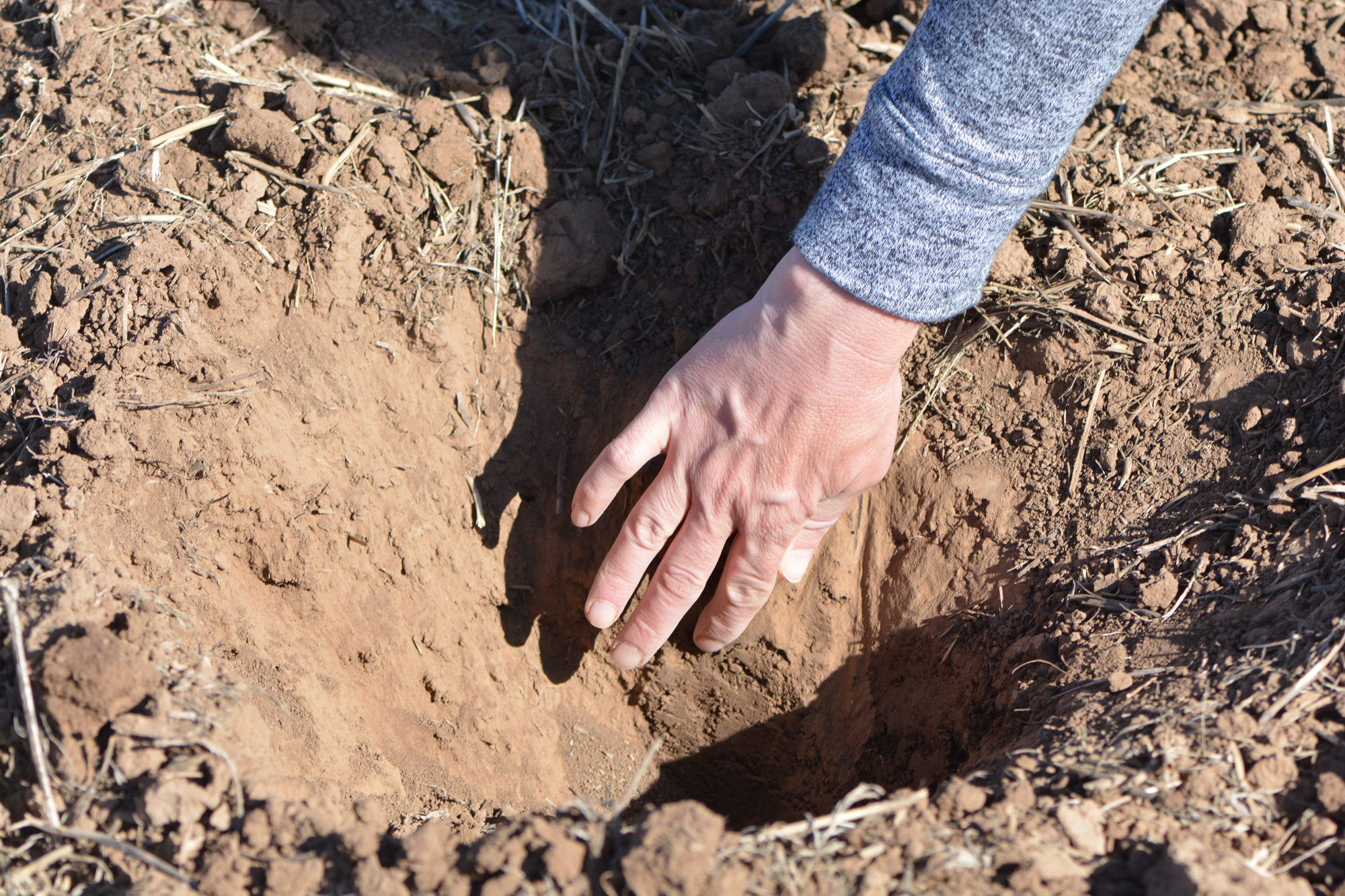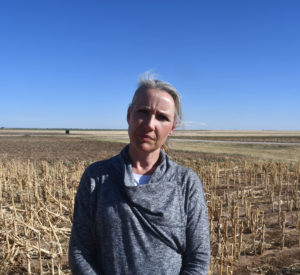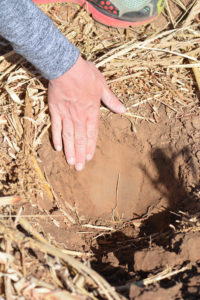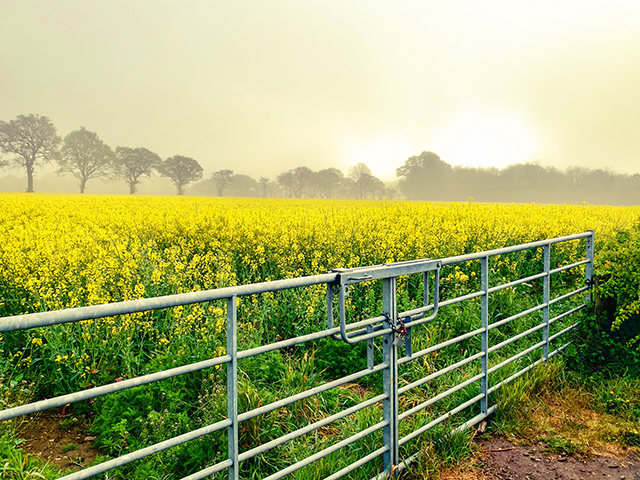Farm & Ranch
[AgriLife Today] Critical Texas drought forecast may alter summer crop planting decisions

By: Kay Ledbetter
Writer: Kay Ledbetter, 806-677-5608, [email protected]
Contacts: Dr. Jourdan Bell, 806-677-5600, [email protected]
AMARILLO – The Texas High Plains is under extreme drought and if current conditions continue, producers need to make important decisions for summer crops, said Dr. Jourdan Bell, Texas A&M AgriLife Extension Service agronomist in Amarillo.

Dr. Jourdan Bell, Texas A&M AgriLife Extension economist, said the lack of moisture over the winter may have High Plains producers tweaking their planting decisions. (Texas A&M AgriLife photo by Kay Ledbetter)
“The current U.S. Drought Monitor is reporting we are in a Stage 4 drought,” Bell said. “With that, many producers are having to make critical management considerations as they are approaching summer planting season.”
Fortunately, the region’s extended precipitation forecast is improving, she said. The National Weather Service Climate Prediction Center is now predicting the region will have equal changes of above or below average precipitation.
“What does that mean for a producer? Well hopefully it will not be as dry as previously predicted, but we still do not have a positive forecast,” Bell said. “Unfortunately, temperatures are still projected to be above average, and because temperatures are a key driver in crop water use, we are still at risk for crop stress under dryland and limited irrigation.”
With summer planting, it is important to know how much moisture is in the soil profile, “because that is our bucket,” Bell said. “With that, it’s also important to know what crops will be planted and what is their rooting depth. That will help us determine how much subsoil moisture we have and how far it will carry a crop through the growing season, especially if we don’t receive timely moisture.”
Many producers are having to pre-irrigate, so they can have sufficient moisture in the seed zone to germinate summer crops, she said. Under dryland situations, producers are having to decide if they are going to postpone planting.
“Our current forecast is actually calling for precipitation. If we do get rain, many producers are evaluating how soon they will plant dryland acreage,” Bell said. “But even with a precipitation event, it will depend on the amount of rain we receive and the rate it falls to determine the effectiveness of the precipitation event. One rain is not going to break the drought situation we are in.”

Subsoil moisture is only about 4-6 inches below the surface in fields where residue was left standing. (Texas A&M AgriLife photo by Kay Ledbetter)
The Texas High Plains is dependent on winter precipitation in the form of snowfall to build up soil moisture during the fallow period, she said. Across the region, negligible snow fell this winter and rainfall has been anywhere from less than a tenth of an inch to about 3/10s of an inch for the entire winter.
“On the bright side, we are very fortunate because we had very good early fall precipitation, so in many areas we still have good subsoil moisture,” Bell said.
She estimated under no-till and especially under good residue, soil moisture may be 4-6 inches deep; under cultivated or tilled ground, subsoil moisture may be 8-10 inches.
“It is important for producers to evaluate the depth to moisture before they begin to pre-irrigate,” Bell said. “Soil moisture sensors are an invaluable tool not only for scheduling in-season irrigation, but also determining how much pre-irrigation is needed.”
That subsoil moisture also allows dryland producers to gauge precipitation in the forecast to determine if it will give them enough moisture to plant on, she said.
“Even if we receive up to a half inch, that’s probably not going to be enough, because roots will not grow through dry soil to reach the wetter subsoil.”
The primary crops grown in this region under irrigation are corn and cotton, she said. As producers evaluate the forecast and probability of precipitation, many are opting to split irrigated acreage between corn and cotton so they will have sufficient water to meet critical crop water demands throughout the summer.
“For crop insurance purposes, corn needs to be planted on or before June 5 for counties in the Texas High Plains, but planting later in June shifts the critical water demand period of tasseling out of some of the hotter periods of summer,” Bell said.
“Often we will see greater kernel set and sometimes benefits by planting that crop even later in the summer. So, producers have to evaluate how they manage their insurance programs with regards to their planting times.”
For grain sorghum under both irrigated and dryland production systems, producers do have flexibility with planting dates, she said.
“We do find producers are able to make a very good sorghum crop, even planting into late June. That does provide a little bit a flexibility as they watch the weather,” she said. “They can wait and plant the crop if we receive timely rains. Also, planting later will move that critical growth stage of growing-point differentiation and flowering later into the season when we are not as hot. Sorghum does have a little more flexibility than cotton.”
When it comes to cotton across the High Plains, it is important for producers to get the crop planted in May because “we are trying to grow a perennial crop in a very short annual environment,” Bell said. “In order to accumulate sufficient growing degree days or heat units to mature that crop and optimize production – not just yield but also quality – we really need to get that crop off and running in May and preferably early to mid-May if conditions are favorable.”
Another challenge producers may have, especially under dryland conditions, is herbicides, she said. In some years, sufficient precipitation is not received to activate some of the residual preplant herbicides.
“Preplant herbicides are very important because we want to minimize competition with our primary crop,” Bell said. “We want to start the season weed free. Weeds are using water we need for the crop, so they must be managed.”
All these decisions can be tricky because producers often have made their seed selection months ago, she said. So moving into a dry period there might be some limitations on the decisions a producer can make.
“Irrigation helps stabilize production and minimizes the risk we encounter under dryland,” Bell said. “But across much of the High Plains, well capacities are no longer sufficient to meet crop water demands to optimize economical production. And often our precipitation, while aiding crop water demand throughout the season, doesn’t come at the most ideal time.”
She said the High Plains often receives non-beneficial precipitation. Rain events may only measure a few hundredths of an inch or 2-3 inches may fall in a very short time and a large percentage of this runs off. Neither event benefits crop production.
“Really, what we want to see are those slow, steady rains that come over the course of several days and soak in, wet up that profile, and really provide soil moisture.”
Traditionally the best rains in this region fall in May and June, and that offers hope for the coming crop season, in spite of the current drought, Bell said.
-30-
Find more stories, photos, videos and audio at http://today.agrilife.org
Farm & Ranch
Land Market Report: March Land Sales

By Jared Groce
Rural land sales are continuing on a steady pace for early spring, with prices holding very strong with the sell-to-list price ratios remaining very high, even on properties that have been on the market for a longer than usual time period. The total number of transactions are picking up once again as the spring selling season kicks off, and the average acreage continues to decrease.
Larger acreage properties seem to be in higher demand than smaller properties currently, with many buyers simply parking cash in real estate to hedge against inflation. Interest rates seem to have settled down and most experts agree that rates will be reduced by the fed this year. Some lenders have programs in place that allow the buyer to reduce their rates without having to go through a full refinance ordeal.
To read more, pick up a copy of the May issue of NTFR magazine. To subscribe by mail, call 940-872-5922.
Farm & Ranch
Texas FFA State Vice President Weston Parr

Future Farmers of America was founded by a group of farmers in 1928 with the mission of preparing the next generation of agriculture. It has done just that during its 95-year history, as the organization works to give back to others by following its motto, “learning to do, doing to learn, earning to live, living to serve.”
FFA is an organization made up of state associations, and at the helm of the Texas FFA is a team of 12 officers representing their respective areas within the Lone Star State. These individuals dedicate a year of their lives as they serve members, provide leadership, and work together with the state staff and board of directors to develop policy and lead the organization of over 177,000 members.
North Texas is represented by Area IV and Area IV, stretching from Wilbarger County to Bell County and from Runnels County to Grayson County. This year, those chosen to lead this great area are State President Isaac Hawkins Jr., Area IV, and State Vice President Weston Parr, Area V.
Parr is from the Sam Rayburn FFA chapter and the Area V Association, but the leader who now serves more than 19,100 members of Area V entered the FFA organization as a shy teenager who sat in the back of the room.
“I didn’t talk to a whole lot of people. I didn’t know what I wanted to do with my life or where I could see myself, so I wasn’t involved on my high school campus,” Parr recalled.
“Then I started FFA and slowly but surely, my ag teachers worked me into attending more contests, meeting new people, and speaking. I remember the first time I gave an officer speech to my chapter. I can still remember how embarrassing it was. To see the progression from that moment to speaking on stage at the state convention in front of thousands of people. Now I feel like I can enter the industry I want and be successful all because of what FFA afforded me for five years.”
There is not much Parr did not do during his time in high school. His contest participation included chapter conducting, wool judging, cotton judging, wildlife, and job interview, but his favorite was extemporaneous speaking, which he did not start until his senior year of high school.
“I wish I could go back to my freshman, sophomore, and junior years and start that sooner. I think if I had more time, I would have been more successful than I already was, but that was something I didn’t realize I liked at the time. I’m not naturally somebody who likes to speak in public, but it was actually my favorite,” Parr said.
Parr won several awards during his time competing. In 2023 alone, Parr earned the Texas FFA Service-Learning Proficiency title, was a National FFA Service-Learning Proficiency finalist, and a Texas FFA Extemporaneous Speaking finalist. In addition to his CDE and LDE events during high school, he showed commercial steers at Houston, and boilers at most major shows, participated in the county show with projects in ag mechanics, showed goats from time to time, and showed heifers until graduation.
“FFA provides invaluable resources and knowledge to be successful once you leave high school and you are out of the blue jacket for the first time. I have been a part of a lot of great organizations over the years, and they are all great in their own way, but in my opinion, FFA is the most successful at producing members of society who want to go and do something with themselves,” Parr said.
He was halfway through his time as Area V Association President and attending the national convention when he began to ponder the idea of running for state office.
“This is around the time when you usually figure out if you want to go through and be a state officer or you decide that area officer is your last run. I was unsure of where I wanted to go, but I knew I didn’t want to be done with FFA. I decided maybe it would be a good opportunity not only for me to make more friendships and connections, but also to give back to the program that allowed me to be able to do what I can do today,” Parr explained.
To read more, pick up a copy of the May issue of NTFR magazine. To subscribe by mail, call 940-872-5922.
Farm & Ranch
Texas FFA State President Isaac Hawkins, Jr.

FFA is an organization made up of state associations, and at the helm of the Texas FFA is a team of 12 officers representing their respective areas within the Lone Star State. These individuals dedicate a year of their lives as they serve members, provide leadership, and work together with the state staff and board of directors to develop policy and lead the organization of over 177,000 members.
North Texas is represented by Area IV and Area IV, stretching from Wilbarger County to Bell County and from Runnels County to Grayson County. This year, those chosen to lead this great area are State President Isaac Hawkins Jr., Area IV, and State Vice President Weston Parr, Area V.
These young leaders share a drive to give back to the organization that has given to them as they work to support FFA members while preparing for a future in the agricultural industry.
From the 12 selected representatives, delegates elect a president and first vice president, with the remaining 10 serving as vice presidents from their respective area associations. The selection process consists of a popular vote by delegates at the state convention, which accounts for 40 percent of the decision, and a committee process that includes a written knowledge exam, worth 10 percent, and an interview, accounting for 50 percent. This year, after all was said and done, Hawkins was named this year’s Texas FFA President.
Hawkins grew up as part of a large, blended family with five sisters and three brothers. While he says he did not grow up in agriculture, his youth was spent outside fishing and doing all things outdoors with his father, whom he calls his best friend. As he entered Hirschi High School in Wichita Falls, Hawkins knew he wanted to be a vet but was unsure of what courses to take to set himself on that path.
“I signed up for ag principals just because they had animals in the description. The first day of class we talked about churning butter, and I went to my school counselor that same day and told her to change my schedule immediately, but she refused. She made me stay there,” Hawkins laughed. “Luckily, I had an incredible ag teacher, and she really helped me to fall in love with the program.”
To read more, pick up a copy of the May issue of NTFR magazine. To subscribe by mail, call 940-872-5922.
-

 Country Lifestyles1 year ago
Country Lifestyles1 year agoScott & Stacey Schumacher: A Growth Mindset
-

 Equine7 months ago
Equine7 months agoThe Will to Win
-

 Country Lifestyles7 years ago
Country Lifestyles7 years agoStyle Your Profile – What your style cowboy hat says about you and new trends in 2017
-

 Country Lifestyles4 years ago
Country Lifestyles4 years agoAmber Crawford, Breakaway Roper
-

 HOME7 years ago
HOME7 years agoGrazing North Texas – Wilman Lovegrass
-

 Country Lifestyles7 years ago
Country Lifestyles7 years agoDecember 2016 Profile, Rusty Riddle – The Riddle Way
-

 Country Lifestyles8 years ago
Country Lifestyles8 years agoJune 2016 Profile – The man behind the mic: Bob Tallman
-

 Outdoor9 years ago
Outdoor9 years agoButtercup or Primrose?






